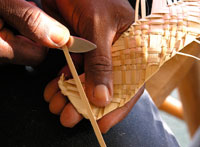| Straw Craft |
|
by Allie O'hora
Nearly all straw workers are women, the traditions passed down from their mothers and grandmothers. Weavers begin by collecting and plaiting the straw, which is actually not straw at all but a type of palmetto frond, made of the young, unopened fronds at the top of the tree. The palmetto fronds are then dried, cured, and cut into strips. The strips are woven into rolls, which is the raw material that most straw workers use in their work. There are at least 25 different weaving patterns, with names like Jacob's Ladder, Bahama Mama, and Peas 'n' Rice.
It takes about eight hours to plait a ten-foot roll, and some more involved patterns, such as the pineapple, can take even longer. Each of the Out Islands has a unique weaving and plaiting style -- on Long Island, for instance, straw workers give their products a coat of varnish. Straw work became a commercial industry as early as the 18th century. Penelope Phenney, the wife of one of the colonial governors, created a local market for the baskets, containers, and woven crab pots made by the plaiters. The commercial straw industry died after the departure of the Phenneys, but it was revived in the mid-19th century, when plaiters began to sell items to the first winter tourists. In the 1920s, vendors started to sell their creations to cruise ship passengers from the U.S. and America. Straw vending grew in popularity along with the three-month tourist season, with the encouragement of the British government, and plaiters organized and established markets to sell their wares, some of which are still in operation.
|








